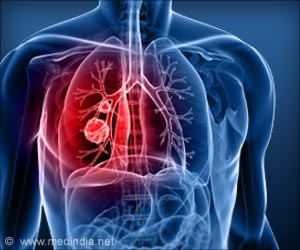The new findings are based on human and laboratory research on mutations in a gene called EGFR which are seen in about half of people with lung cancer who have never smoked. In a study of nearly half a million people living in England, South Korea and Taiwan, exposure to increasing concentrations of airborne particulate matter (PM) 2.5 micrometres (μm) in diameter was linked to increased risk of NSCLC with EGFR mutations.
In the laboratory studies, the Francis Crick Institute scientists showed that the same pollutant particles (PM2.5) promoted rapid changes in airway cells which had mutations in EGFR and in another gene linked to lung cancer called KRAS, driving them towards a cancer stem cell like state. They also found that air pollution drives the influx of macrophages which release the inflammatory mediator, interleukin-1β, driving the expansion of cells with the EGFR mutations in response to exposure to PM2.5, and that blockade of interleukin-1β inhibited lung cancer initiation. These findings were consistent with data from a previous large clinical trial showing a dose dependent reduction in lung cancer incidence when people were treated with the anti-IL1β antibody, canakinumab (4).
Advertisement
In a final series of experiments, the Francis Crick team used state-of-the-art, ultradeep mutational profiling of small samples of normal lung tissue and found EGFR and KRAS driver mutations in 18% and 33% of normal lung samples, respectively.
“We found that driver mutations in EGFR and KRAS genes, commonly found in lung cancers, are actually present in normal lung tissue and are a likely consequence of ageing. In our research, these mutations alone only weakly potentiated cancer in laboratory models. However, when lung cells with these mutations were exposed to air pollutants, we saw more cancers and these occurred more quickly than when lung cells with these mutations were not exposed to pollutants, suggesting that air pollution promotes the initiation of lung cancer in cells harbouring driver gene mutations. The next step is to discover why some lung cells with mutations become cancerous when exposed to pollutants while others don’t,” said Swanton.
Commenting on the results, Tony Mok, Chinese University of Hong Kong, not involved in the study, said: “This research is intriguing and exciting as it means that we can ask whether, in the future, it will be possible to use lung scans to look for pre-cancerous lesions in the lungs and try to reverse them with medicines such as interleukin-1β inhibitors. We don’t yet know whether it will be possible to use highly sensitive EGFR profiling on blood or other samples to find non-smokers who are predisposed to lung cancer and may benefit from lung scanning, so discussions are still very speculative.”
Like Swanton, he stresses the importance of reducing air pollution to lower the risk of lung diseases, including cancer. “We have known about the link between pollution and lung cancer for a long time, and we now have a possible explanation for it. As consumption of fossil fuels goes hand in hand with pollution and carbon emissions, we have a strong mandate for tackling these issues – for both environmental and health reasons,” Mok concluded.
Source: Eurekalert



